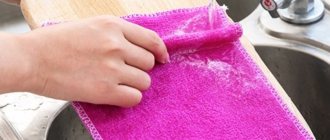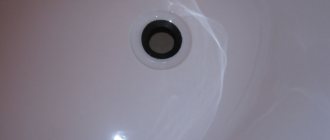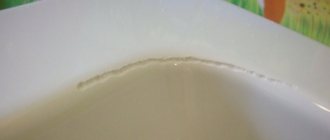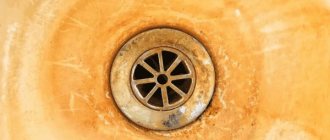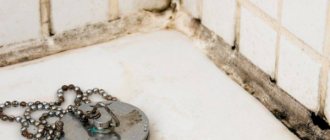Active cleaning of an acrylic bathtub can lead, contrary to expectations, to a gray and yellowish coating. The reason for this is the sensitivity of acrylic to aggressive detergents.
A properly selected cleaning composition for surface care is the key to maintaining the whiteness of your plumbing fixtures. How to wash a hot tub at home will be discussed in detail in our article.
Rules for caring for acrylic plumbing fixtures
Acrylic is a polymer material with a small number of pores. Dirt particles do not stick to its smooth surface, but fats easily stick. A greasy environment is favorable for the appearance of microorganisms, lime deposits and rust.
When cleaning an acrylic bathtub, you should not use products containing chlorine, acetone, or ammonia: they destroy the acrylic layer and cause cracks to appear. To avoid damaging the coating, do not use aggressive alkaline or acidic cleaning fluids. For the same reason, choose gels without abrasives and use only soft brushes and sponges.
Do not pour hot water into the bath. The permissible temperature for cast acrylic baths is not higher than 80 °C, and for a sandwich sheet - from 50 °C to 70 °C. Wash the bathtub with warm water at a temperature of up to 40 ° C, this is enough to remove dirt.
Characteristics of acrylic surfaces
Acrylic bathtubs are resistant to corrosion. They are often installed instead of old steel and cast iron products, which after 5-7 years of operation lose their appearance. Acrylic is a polymer that, once applied to a surface, forms a durable and elastic coating. It contains a minimal number of pores, so it does not absorb dirt.
Properties
Acrylic has a number of specific qualities, including:
- average thermoplasticity;
- ability to soften at temperatures above +90…+100°C;
- bending resistance;
- low thermal conductivity, etc.
The density of this material is much less than that of glass, and is 1180-1190 kg/cub.m. It does not react with most solvents.
Advantages
Bathtubs with acrylic coating have the following advantages:
- fast heating;
- light weight;
- high resistance to ultraviolet radiation;
- glossy shine;
- dense surface without cavities and pores;
- resistance to detergents;
- resistance to rotting and fungus;
- ability to muffle sounds;
- possibility of polishing.
Advantages and disadvantages of acrylic bathtubs.
How to remove limescale
Homemade acrylic bathtub cleaners gently remove limescale from acrylic surfaces.
Table vinegar
Use only 9% vinegar, not 72% vinegar essence. Add one liter of table vinegar to a bathtub filled with water and leave overnight. The solution should stand overnight, but no more than 10–12 hours. Then drain the solution, rinse the bathtub and dry with a soft cloth.
Soda
Soda is a weak alkali that will not damage acrylic, but the powder cannot be used in its pure form and should not be rubbed with a sponge, otherwise the surface may be scratched. It’s better to prepare a solution: dilute one pack of baking soda in a bathtub filled with water. The water temperature should be 40˚C. Leave the solution for one hour, then drain and rinse. Old limescale deposits can be easily removed with soda slurry: add a little water to the soda and cover the limescale stains of the bath with it for 25–30 minutes, and then rinse off.
Lemon acid
Add 50–100 grams of citric acid to a bathtub filled with warm water. Mix the solution well and leave for 10–12 hours. Then drain the solution, rinse the surfaces and wipe the bath with a dry cloth.
Household chemicals
The retail chain sells a wide range of products for the care of acrylic surfaces; their distinctive feature is the inscription Acrylic on bottles or containers. Consumers are well aware of such brands as Bass, Sif, Zolushka, Chister, Ravak, Akrilan, Sanox, Silit, Tim-Profi, produced in the form of gels, pastes or spray liquids.
The packaging of each composition contains instructions for use; the standard cleaning method is to apply (spray) onto the bowl and wash off the deposits with warm water after some time. Most popular gels are squeezed onto a rag (sponge), spread over a bowl, left for 15 minutes, and removed with hot water, then wiped dry.
How to wash yellow plaque
Yellowness is formed due to increased hardness of water that comes from the water supply. It can be dealt with using improvised means.
Hydrogen peroxide and vinegar
Mix hydrogen peroxide and vinegar in a 3:1 ratio. Apply the solution to the yellowed areas and leave for 15 minutes. Then rinse the bath thoroughly with water. The solution can be applied with a rag, but better - with a sprayer.
Mustard and soda
Mix mustard and soda in a 1:1 ratio and add water to make a paste. Apply the paste to the yellowish area, leave for one hour and then rinse the bath thoroughly.
Laundry soap
The fattier the laundry soap, the better it removes yellowness. Grate the soap and add water. Add 2-3 tablespoons of baking soda to the soap, mix thoroughly and treat the yellow stains. Leave on for one hour and rinse off.
Method 9: laundry soap
We suggest washing the acrylic with a solution of soap shavings. Suitable for household or regular children's clothes.
Procedure:
- For 500 ml of hot water - 15 g of soap. It is rubbed into fine shavings.
- For effectiveness, add 1 tbsp to the solution. l. baking soda.
- The solution is stirred well so that the chips and granules are completely dissolved.
- Cover the surface with the warm mixture, leave for half an hour, then rinse thoroughly.
How to remove rust
Rust is formed from water with a high iron content and in advanced cases it is difficult to remove. Homemade cleaning products can save your acrylic bathtub.
Lemon juice
Apply fresh lemon juice to the rust stain and leave for one hour. To enhance the effect, treated with juice of places
Sprinkle salt, but do not rub it into the surface: this can scratch the bathtub. Then rinse with warm water.
Ammonia and hydrogen peroxide
Both products are aggressive, so they should be kept on the surface of the bath for no more than 10 minutes. Mix ammonia and hydrogen peroxide in a 1:1 ratio, stir and treat the rust. Leave for five minutes and rinse the bath thoroughly with water.
Method 6: baking soda
One of the most popular products for cleaning items at home is baking soda. The product effectively removes blackness, rust and regular yellow plaque.
How to use baking soda wisely:
- Make a paste and apply evenly to areas of contamination.
- Leave for 10-15 minutes.
- Wash off with a stream of water.
Important You need to make a paste out of soda, otherwise the granules will scratch the acrylic. But even then it is forbidden to rub the product in: it will ruin the protective layer of the surface.
What special tools can be used
If the previous methods did not help, then special cleaning products will come to the rescue that will carefully remove dirt:
- B&B Unicum. A universal product for cleaning acrylic bathtubs from rust, lime deposits, fungi and mold, and soap scum. Creates a protective film on the surface of the bathroom and gives it shine.
- Acrilan. Cleaning foam removes rust, limescale, fungi and microorganisms. Akrilan also successfully copes with old stains.
- Cif cream with microcrystals. The product removes rust, greasy and limescale deposits, soap traces and does not scratch the surface of the bathtub. It has a pleasant aroma and is economical to use - 2-3 drops are enough for one cleaning. Thanks to active microcrystals, it removes even heavy dirt.
- Cinderella. An inexpensive acrylic bathtub cleaner that removes any dirt. It has a strong smell, so it is better to wear a protective mask.
Before you start using detergent, you need to moisten the surface with cool water.
Prohibited tricks
Before you start cleaning such products, it is important to understand what should not be used in such work. The following tools and available materials are considered undesirable:
- Abrasive detergents are powders containing crystals. They can scratch the sensitive surface, which will not only ruin the appearance of the product, but will become a breeding ground for bacteria that can easily penetrate microcracks. In addition, the shine will leave the surface of the acrylic, it will become dull and unsightly. Abrasives include not only purchased products, but also improvised ones. For example, baking soda or citric acid undiluted in water, tooth powder, etc.;
- chlorine or products containing it. Under its influence, the acrylic surface may darken and swell, and pores will appear on it due to the destruction of the polymer structure. The same applies to substances such as ammonia, acetone and various formaldehydes;
- hard brushes, sponges, washcloths. An ideal alternative to such items is a soft cloth;
- very hot water. It is no less dangerous for the acrylic surface than acetone or solvent. When exposed to high temperatures, the surface of the bath may become deformed.
How to disinfect a bath
It is necessary to disinfect the bathtub, since during use, grease and microbes appear on the surface. Disinfection is carried out using three methods:
- Use of cleaning products “Acrylon”, “Acrilight”, “Santech”. Pour water over the bath, then treat it with the product. Leave on for 2-3 minutes, rinse and wipe with a dry cloth.
- Fill the bath with water at a temperature of 40˚C and pour in two bottles of “Whiteness”. Leave for 15 minutes and drain the water. Then pour warm water again, wipe the entire surface of the bathtub, pour out the water and wipe with a dry cloth.
- You can disinfect it with a steam cleaner twice a year. But do not process the bath for a long time, so as not to melt the polymer layer.
How to remove small scratches
When using an acrylic bathtub, small scratches, chips and cracks appear. If they are not removed, the polymer layer will begin to deteriorate. To remove minor scratches:
- Sand the damaged area with P60 grit sandpaper. Then sand to a matte surface using P240 sandpaper;
- Degrease the area with solvent 646 or acetone.
- Coat the prepared area with car polish using a spatula.
- Let dry and sand with P1500 sandpaper and coat with polish.
For deep damage, it is better to contact a specialist.
alist, otherwise there is a risk of damaging the coating forever. And to avoid damage, do not soak or wash clothes in the bath - powders and bleaches can damage the coating. Also, do not place basins, buckets, stools or heating equipment in the bathtub.
Features of cleaning a whirlpool bath
There are two methods for cleaning such bathtubs:
- Special products for hydromassage baths are added to a bathtub filled with water and the hydraulic system is turned on for 5–7 minutes. Then turn off the hydraulic system and leave the solution for 2–3 hours. Drain the solution and clean the nozzles with hydrogen peroxide. Fill the bath again, but without adding any cleaning agent, and turn on the hydraulic system.
- This method uses 150 g of citric acid, which is pre-dissolved in a small amount of water. The sequence of operations is the same.
Using Sanox
This is a more affordable analogue of Domestos. Its main active ingredient is hydrochloric acid. The product is produced in the form of gel, spray and foam. Sanox is used for removing complex stains, disinfecting and bleaching. You need to work with it wearing gloves and a respirator.
A small amount of product is applied to a sponge and evenly distributed over the moistened walls. After 3 minutes, wipe the surface and rinse with water. If necessary, repeat the procedure.
Sanox carefully removes dirt and effectively fights germs.
Briefly about the main thing
- Acrylic bathtubs can be cleaned using homemade or special household products - the choice is yours.
- To prevent the appearance of rust, yellow plaque and grease, do not forget about care - wash the acrylic bathtub with a soapy sponge and wipe with a dry cloth.
- Disinfect your bath regularly using any method.
- Avoid aggressive products, do not use hard sponges and do not place heavy objects or containers with hard bottoms in the bath.
- For deep stains, when no other product helps, entrust the cleaning of the bathtub to an apartment cleaning service.
Operating rules
operation of acrylic bathtubs
Daily cleaning is the key to ensuring that the plumbing fixtures retain their presentable appearance for a long time. It is also important to follow additional recommendations when leaving:
- Getting rid of rust will be problematic. To prevent it from appearing, always close the shower and taps tightly, and also check that they are in good working order.
- Test any detergent that you are going to use for the first time.
- Do not use scrapers or hard brushes to deal with stubborn stains, as they can easily scratch the acrylate.
- Any chemicals, even those approved for this type of plumbing, should not be used more than 2 times a month.
- To ensure that the acrylic bathtub coating has additional dirt-repellent properties, regularly apply a wax-based polish to it.
- Always wipe the bathtub dry after using it to prevent deposits from forming on the surface.
